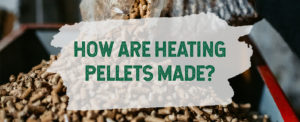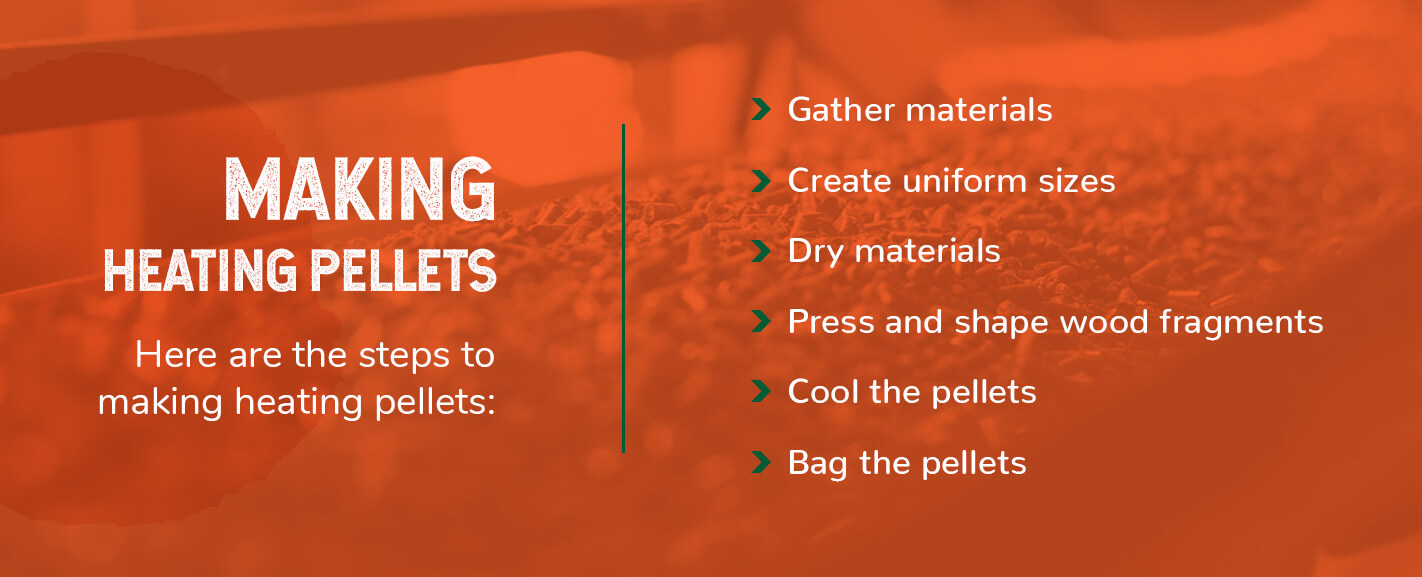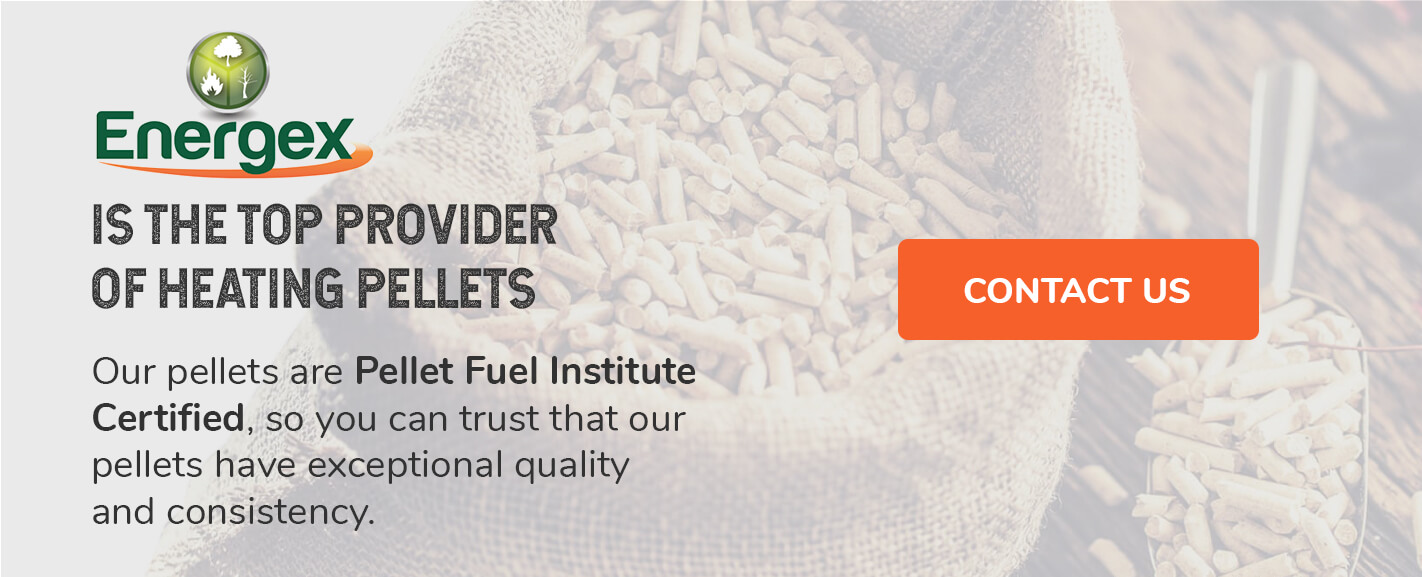How Are Heating Pellets Made?

In recent years, pellet appliances are more popular than ever before among homeowners. As many people embrace being environmentally friendly, pellets provide homeowners with a sustainable source of energy. Unlike their counterparts, appliances that use heating pellets burn renewable biomass pellet fuel, making it significantly less harmful to the ecosystem.
Want to know how to make heating pellets? Below, we’ll share what heating pellets are made of and the process for creating them.
- What Are Heating Pellets?
- What Are Heating Pellets Made Of?
- How Are Heating Pellets Made For Consumers?
- Are Heating Pellets The Right Choice For You?
- Contact Energex For More Information About Heating Pellets
What are Heating Pellets?
Pellets are compressed biomass products made of renewable materials that turn old waste into new energy. These pellets provide heat for companies and organizations across the country, like schools and prisons. On a smaller scale, pellets are used in stoves, boilers and furnaces to heat homes. These pellets contain a remarkable combustion quality and high energy density.
Approximately 1 ton of heating pellets equals 120 gallons of heating oil and 170 gallons of propane, which makes it an eco-friendly choice for heating your home. The Energy Information Administration estimates that 1.4 percent of U.S households used pellets as their primary heating source last winter.
What are Heating Pellets Made Of?
Pellets can be made from a variety of organic materials, including industrial waste. The most common type of pellets are made of wood. Generally, wood pellets come from a combination of sawdust and waste from manufacturing or construction applications. The sawdust, woodchips and waste get heated and pressurized to form the pellet. Aside from wood pellets, there are alternative heating pellets made from waste paper or grass.
With wood pellets remaining the most popular option, there are different types you can buy. Wood pellets fall into two categories:
- Softwood pellets: These pellets produce between 10% to 20% BTUs when burning, meaning that they typically have higher heat output. Softwood pellets also have lower ash content.
- Hardwood pellets: Due to their greater density, hardwood pellets generally burn longer than softwood pellets. Most manufacturers’ hardwood pellets have far more ash content than softwood pellets.
Overall, the most significant difference between softwood or hardwood pellets is the rate at which they burn. Aside from the type of pellet, the most critical factor to consider when choosing wood pellets is the quality.
You want to use high-quality pellets to prevent ash build-up in your stove. Premium-grade pellets use higher quality materials, which makes them a better option. These pellets have an ash content that’s less than 1%, while standard grade pellets can have up to 3% ash.
When looking at pellets, it’s critical to see the composition and how much ash they produce to ensure you get the best pellets for your stove.
How Are Heating Pellets Made for Consumers?

Making heating pellets can be a long and technical process. Here are the steps to making heating pellets:
-
Gather materials: As mentioned previously, pellets contain a combination of substances. To start making the renewable energy source, manufacturers obtain large quantities of raw materials and bring them to their facility. The manufacturer then processes the raw materials so that they have consistent moisture content, heat value and burn characteristics.
-
Create uniform sizes: Pellet mills process materials that are a variety of shapes and sizes. However, machines must break the materials down into uniform sizes for the materials to provide a consistent heating value. Large materials, like wood, are placed in a woodchipper to turn pieces into smaller, similar-sized pieces. Smaller materials such as sawdust get ground down to create consistency.
-
Dry materials: Raw materials exposed to humidity are likely to have excess moisture. Excess moisture can cause poor consolidation of the pellet, which results in dust in the final product. The grounded materials are passed through large dryer drums to attune the moisture content among the different materials and remove any excess water. In the end, most wood heating pellets have a moisture content between 5% and 10%. Any moisture level higher than 10% will result in a poor product.
-
Press and shape wood fragments: After drying, materials pass through high-pressure dies. This process enables sawdust and other materials to bind together through heating. It is a crucial step because it determines numerous characteristics of the product, including density, size, and durability. The manufacturer creates specific settings on their pellet mill to determine how the product will turn out once it passes through the mill.
-
Cool the pellets: Hot heating pellets are at risk of breaking. To preserve them, heating pellets are placed in a cooling tower, like a silo, for hardening. The pellets will remain in the silo to maintain their integrity until they’re ready to get bagged and distributed.
-
Bag the pellets: The manufacturer will bag the pellets on they’re ready for distribution. The pellets typically come in 40-pound bags. Once bagged, the manufacturer must store the pellets in a temperature-controlled area to ensure that the pellets don’t attain any moisture and ruin the quality of the product.
Are Heating Pellets the Right Choice For You?
Choosing to heat your home with pellet fuel comes with many benefits, making them the optimal heat source for you.
Here are some benefits of choosing to use heating pellets:
-
It is cost-effective: Heating pellets are far more cost-efficient than having something like propane heating. The average cost of pellet fuel per million BTU is $19.05. To reach that level of economic efficiency, propane would have to be $1.36 per gallon. Since propane is usually $3 or more per gallon, pellets are more cost-effective for you. Additionally, some pellet appliances can also qualify for an income tax credit too.
-
It is easy to use: Using a pellet stove is easy and efficient. You don’t have to spend time chopping up your fuel source to heat your home. You typically only need to load your pellet stove once a day, as the stove can hold between 35 to 130 pounds of pellets at a time.
-
Pellet appliances require minimal maintenance: Because heating pellets are manufactured to have low moisture, it requires less cleaning for you. You can buy wood pellets that produce less ash, making your stove easier to clean and maintain.
-
Pellet fuel is better for the planet: Almost everything we do emits carbon dioxide into the atmosphere, which negatively impacts the environment. However, the amount of carbon emitted while burning wood pellets equals the amount absorbed by a tree, making it a carbon-neutral activity. Unlike fossil fuels such as oil and natural gas, which are in short supply, wood pellets are a renewable resource.
Contact Energex For More Information About Heating Pellets
Energex is the top provider of heating pellets. Our pellets are Pellet Fuel Institute Certified, so you can trust that our pellets have exceptional quality and consistency. In addition to the PFI standards, we conduct scientific lab testing that monitors the moisture, ash, clean virgin wood fiber, durability, and more to ensure you get the best product.
Set up a bulk delivery for maximum convenience if you’re located in Pennsylvania, or find a retailer near you. If you have any questions about which heating pellets are ideal for you, contact our expert team online. We are here to help!


